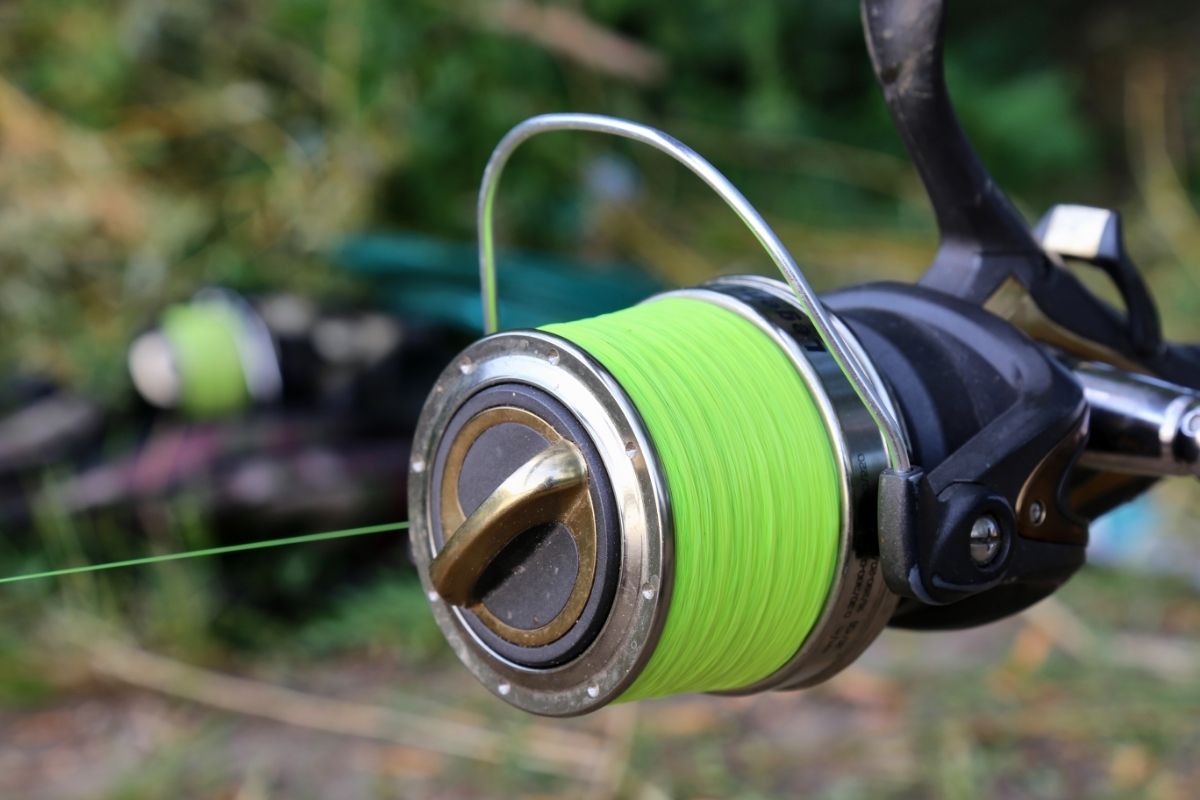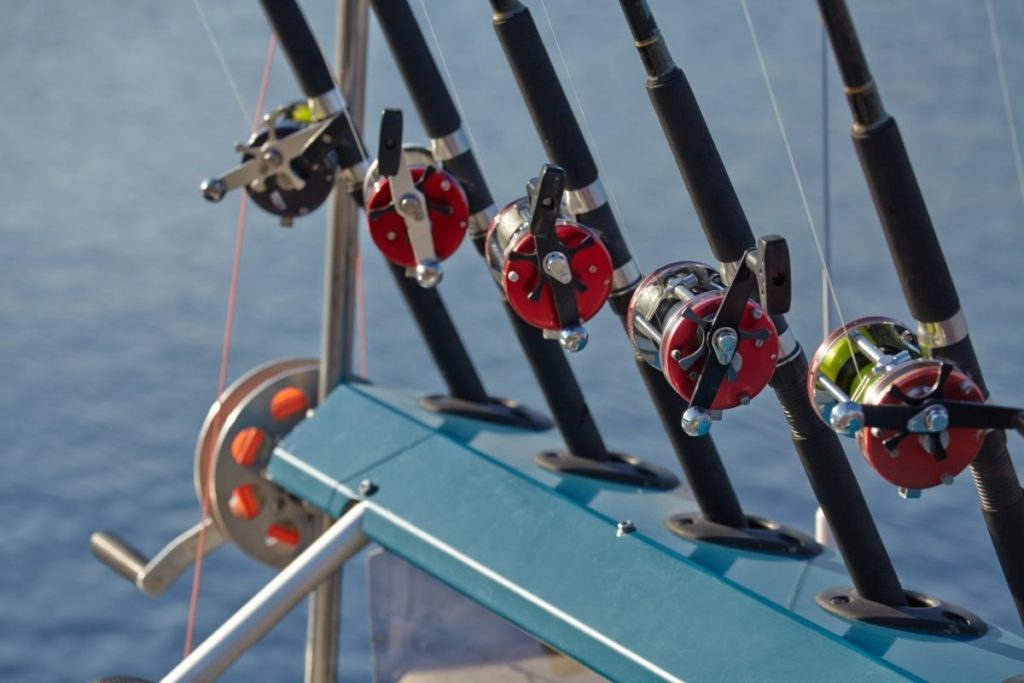Fishing is an entertaining sport enjoyed by millions of people around the world. However, it is also a technical sport that can be quite difficult to get the hang of, especially if you’re a beginner.
With lots of specialized equipment required and high levels of skill needed to catch any fish, something that may seem simple to a professional can be incredibly hard for someone just starting out.

An example of this is putting a new line on a fishing reel. There will come a time when every angler has to put a new line on their fishing reel as lines can twist, tangle, and break.
The process can be quite awkward and tricky for beginners that have never done it before, with there being precise steps to follow.
To make life easier for beginners, in this article we will show you exactly how to put a new line on a fishing reel.
By the end, you’ll be able to change your fishing line in just 10 minutes!
The Different Types Of Fishing Reel
Before we look at each step required to put a new line on a fishing reel, it is important to understand the different types of fishing reel used. This is important because reels vary in the way they work.
As a result, how you might set up a new line on one type of reel might be completely different from another.
The two main groups of fishing reel are fly and spinning. Each of these groups then contains two or three other different types of reels.
In this article, we will be focusing on spinning reels as they are the most popular type of reel and the one you’re most likely using.
There are three different types of spinning reel. You’ll find information about each type below.
Spinning
Spinning reels are probably the most popular type of fishing reel you will find, especially amongst beginners. They are easy to set up and even easier to use.
The line capacity on these reels is also high so you can put a very long line on the reel.
The only problem spinning reels face is when using heavier lines. This is when the lines don’t perform very well. However, you can keep a spare spool and effortlessly change it on the go which is a bonus.
Baitcasting
This is a more difficult type of reel to use, and one that typically isn’t recommended for beginners. If not controlled properly the line can easily tangle or break so you might want to avoid these lines for now.
Baitcasting lines are a good choice when using lures and heavy lines.
Spincast
A completely closed type of reel, every part of a spincast reel is kept in a cover, with the line peeking through a tiny opening. This reel is a great option for first-timers and newbies.
It is also an excellent choice for children. The only issue with spincast reels is that they can struggle with distance and accuracy.
This reel is easy to operate though. You only need to press a button when casting.
Now that you know more about the three types of spinning reels, we can start looking at how to put a new line on each one.
Putting A New Line On A Spinning Reel
We’ll start off with the most popular type of spinning reel. While it may seem like an overwhelming task at first, changing the line of a spinning reel isn’t actually that difficult when you know what you’re doing.
It might take you a few tries to become a natural, but by following the instructions below, you should be able to get good at it pretty quickly.
1. Take your reel and hold it like you would when fishing. Then turn the reel wheel a couple of times so you can identify which way the reel is turning. This will show which way the line needs to be spooled. If the line is spooled wrong, it could rip when you cast. Unlike baitcasting and spincasting reels, spinning reels have to be mounted to the bottom of the rod.
2. Open the reel bail. This can be done by overturning your reel’s small handle up (to open) and down (to close). Any old line that has been leftover in the reel should now be removed.
3. String your new line through the spinning reels guides and ensure it is securely in place with the spool. Make sure you also leave plenty of line after the knot.
4. You can now close the reel bail. Next, you should place your spool on a flat surface. A table will do. The reels label should sit on top. Your line needs to come from the spool exactly the same way the spool has to go into the reel. By turning your spool the correct way, you can prevent any tangling.
5. Keeping hold of your new line, gently crank your reel. You should hold it roughly 30 cm above before pulling it. As you crank your reel, carefully let the line flow past your hand. Keep an eye out for any tangles or twists. If you spot any, you have to remove that piece of line and align it with the spool again. Try to put a bit of pressure on when loading the line as this will prevent any more tangling.
6. Crank your reel. This will load your line. Again keep an eye out for any tangles or twists. This part can be quite frustrating. If there are any twists you have to do this part again. Don’t rush this step if you want to guarantee success.
7. Fill your spool. You should do this approximately 0.3 cm away from its rim. A spool with not enough or too much line has a higher chance of tangling.
8. Cut your new line. To make it easier for yourself, you can use tape to prevent any unwrapping.
9. Tie a rubber band or lure to the line to keep it secure.
10. All done! You can now continue your fishing journey with a brand new line.
Putting A New Line On A Baitcasting Reel
Putting a new line on your baitcasting reel is quite similar to the method used to attach a new line to a spinning reel. Some people may find it easier as it doesn’t have as many steps.
Some of the steps are also not as complicated which is always nice.

We have detailed how to put a new line on a baitcasting reel below.
1. Pull the new line through the reel’s eyelets. There’s no need to rush this part so take your time to ensure you don’t cause any tangles or twists. That would only slow you down.
2. Attach your line to your spool. Again take your time to avoid any unnecessary mistakes.
3. Wrap the new line around the spool, before tying it in place. You will need to ensure the knot you tie is strong. The last thing you want is a loose knot that could come undone mid-casting. In our experience, the best type of knot to use is an arbor knot.
4. Start spooling. When doing this, it is a good idea to apply pressure to the line. When the tension has been applied, you can begin reeling.
5. Check for any tangles or twists. You can do this as you start reeling the line to make sure the line is set up correctly.
6. Stop approximately 0.3 cm away from the rim.
7. The final thing you need to do is cut any excess line and ensure it is securely in place.
8. All done! You can start fishing again with your new fishing line.
Putting A New Line On A Spincast Reel
Finally, we have the spincast reel.
The process used to put a new reel on this type of spinning line isn’t too dissimilar to the method we have already discussed, but there are a couple of things that have to be done differently.
This is mainly because this type of spinning reel is completely closed.
Therefore, if you miss something out early on, you can’t fix it later without having to start again. To ensure you put your new line on this reel correctly, follow our steps carefully.
We’ve detailed exactly what to do when putting a new line on a spincast reel below.
1. Remove the reel’s face to reveal any leftover fishing line.
2. Make sure any old fishing line that has been left over is removed. This is an easy step, but do make sure every piece of old-line is removed. If left in the reel, tangles and twists can be caused later.
3. Start pulling your new line through the reel. To do this correctly, it is important to follow the reels line guides that sit at the tip of your rod. These guides are round in shape.
4. Pull your new line through the reel. This can be found on the cap of the reel. You have to do this step now as you won’t be able to go back and do it later. There’s no need to fix the cap back yet.
5. In the direction the reel turns, carefully wrap the new line around the spool.
6. Securely tie the new line to the spool. This HAS to be done well because the line can unwrap easily if not.
7. Now, you need to hold the new line and carefully tighten it. You can do this following the same method we used in the spinning reel instructions (step 5).
8. Crank the reels handle. By doing this you will load your line. Keep an eye out for any tangles or twists along the way. If there are any twists you have to do this part again so don’t rush it.
9. Put the reel cover back on. Before doing this, you might want to have another quick glance over things to make sure everything looks good.
10. Cut your new line off.
11. All done! Now you’ve followed the above steps, your new line will be set up and ready to go so get out there and start fishing.
How Much New Fishing Line Should You Put On Your Reel?
Now you know exactly how to put a new line on your fishing reel. Let us take you through some basic things you need to know aside from how to change your line.
We’ll start with how much fishing line you should put on your reel.
Too much or not enough fishing line can cause problems that will prevent you from casting your line successfully.
The most common of these are twists and tangles. To avoid this from happening, it is crucial that you always use the right amount of line.
When changing the line on your fishing reel, you should always make sure there is a 0.3 cm gap between the line on your spool and rim. This is a universal rule that has to be followed.
In terms of how long the line should be, reels vary from brand to brand. This also depends on the type of line too. Most lines are sold at lengths of 150 to 300 yards spools.
A lot of reel manufacturers then recommend a length of 200 yards.
With this in mind, your best bet is to always follow the guidelines and instructions provided to you by the manufacturer.
How Often Should You Change Your Line?
Despite lasting up to 7 years if stored correctly and not used very often, you should ideally change your fishing line every 6 months to 1 year. This is particularly important if you use your fishing rod a lot.
Having said this, how often you do change your fishing line does also depend on the quality and type of your line. For example, monofilament lines are especially vulnerable to sunlight.
Therefore, they will need changing sooner than other types of lines.
On the other hand, fluorocarbon lines aren’t vulnerable to sunlight so they can last a little longer.
Of course, how often you change your lines will also depend greatly on how you look after them. If you don’t care for your rod, you’ll find yourself replacing the lines regularly.
Final Thoughts
While it may seem super complicated at first, especially when you’ve never done it before, putting a new line on your fishing reel isn’t actually that difficult when you know what you’re doing.
It may take you a while to get to grips with it, but hopefully, now we have shown you exactly what to do, you feel much more confident when it comes to finally replacing your line.
We have given you all the instructions you need to safely put a new line on a reel without making any mistakes. Although, if you do make any mistakes, don’t worry, they can be easily solved by repeating the process.
Now you have our instructions, identify which method you need to follow and give it a try. We’re sure you’ll smash it out the park.
- Do You Need An Indicator For Nymph Fishing? - November 16, 2023
- Fishing Safety Tips For Families - September 25, 2023
- What Is The Best Time To Night Fish At A Lake? - September 18, 2023





![Kayak Fishing for Beginners [10 Tips for a Successful Trip] fishing kayak moored on a beach](https://irvinelake.net/wp-content/uploads/2022/12/kayak-fishing-for-beginners-150x150.png)




